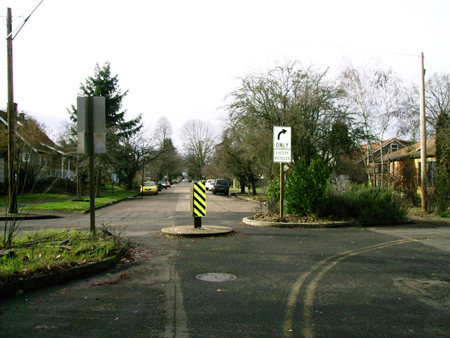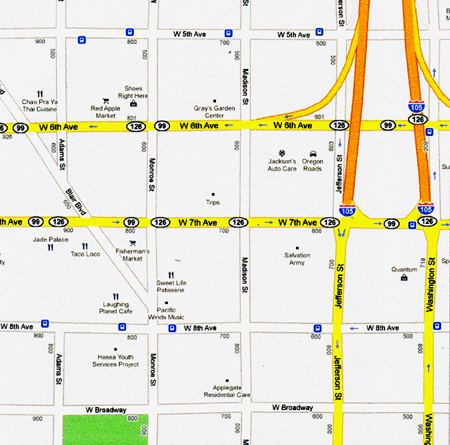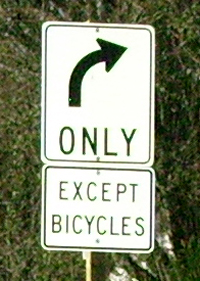Eugene
 Thu, January 21, 2010
Thu, January 21, 2010 
I returned this week from a brief trip to Eugene, Oregon. In 1994, a year after I left the bike business, I moved from Southern California to Eugene.
I lived there until 2001 when I relocated to Charleston, South Carolina. The reason for my trip, to visit my wife’s family.
Eugene is a city where a person could manage quite easily to live without a car; in fact I did just that for the first six months I lived there. They have an excellent public transport service, and they make it easy to ride a bike.
Like many US cities, Eugene has streets that are laid out in a grid. Numbered avenues run east to west, and named streets run North to South.
I always admired the traffic system in Eugene, simple but effective, and coming from Southern California I wondered why other cities, and especially Los Angeles did not adapt a similar system, when a grid street layout is already in place.

In Eugene, 6th Avenue has four traffic lanes one way going west. 7th Avenue has four lanes going east. If you are driving these are the routes that take you from one side of the city to the other, and also link with the freeways.
One block south is 8th Avenue a main bus route east and west, and the next street over which is Broadway, is a bike route.
Cars are not banned from using Broadway, but are simply discouraged from using it as a through route. This is done very effectively by blocking the street every so often in the manner shown in the picture at the top of this article. (Sign indicates right turn only, except bicycles.)
 Cars are forced to make a detour over to the next street; however, a narrow opening allows bicycles to ride straight through.
Cars are forced to make a detour over to the next street; however, a narrow opening allows bicycles to ride straight through.
This means residents on Broadway have access to their homes and can park on the street, but cyclists enjoy a route with very light traffic.
Similarly, bicycles are not banned from using other streets, but a person would be crazy to ride a bike on 6th or 7th Avenues, with the high volume of motor traffic, when they can ride in relative peace and safety just two or three blocks over on Broadway.
There are many traffic lights on the main one-way through routes on 6th and 7th Avenues. However, they are timed in such a fashion that if you drive at the speed limit you will hit a green light every time, from one side of the city to the other.
Locals soon learn this, and there is no point in driving over the speed limit to be stopped at the next light. It is an almost magical experience to drive keeping the needle on the speed limit, and watch every light, one by one, turn to green as you approach.
What a simple idea; bicycles, buses, and cars are separated from each other, and people drive the speed limit. All done by encouragement, incentives if you will, rather than by law enforcement.
I have only touched on a small part of Eugene's bike route system; there are many other streets with bike lanes as well as bike and pedestrian paths.
Other cities, including my adopted home town of Charleston could do well by considering a similar traffic system to Eugene, Oregon. It has been in place many years, and it works.
I’m sure residents would initially be opposed to having their street blocked to through traffic and designated a bike route.
However, they would soon realize that there are advantages too, like easy parking and the relative peace and quiet of living on a street without cars constantly driving past.


















Reader Comments (9)
I wonder how the property owners along Broadway view their street vs the other, higher traffic streets?
I ask because in my city, Austin, the bicycle community is working to get this done on a low volume and is getting tremendous push back from the property owners saying it will drive them out of business.
A followup question - are they mostly residential or commercial? In Austin, it's mostly lawyers and other non-retail commercial on the proposed road.
"There are many traffic lights on the main one-way through routes on 6th and 7th Avenues. However, they are timed in such a fashion that if you drive at the speed limit you will hit a green light every time, from one side of the city to the other."
That, it has to be said, is awesome.
So simple yet so effective! Damn these British roads.
Eric,
As I remember, Broadway in Eugene is mostly residentual, not business. There are trade offs, less through traffic, but easier parking. Apart from fast food restaurants, how much drive by business do retail stores get? Most specialist stores and professional type businesses have a clientele that seek them out via phone book and the Internet and will go where ever they are located.
Dave
I so love that your posting again Dave. I am going to send this link on to several others. I'd love to see something like this in Boulder.
Offer (dis)incentives and they'll just cry "social engineering!"
It sounds like Biketopia!
I would think that restricting motor traffic on a residential street would increase the property value.
In October of 2008 I was lucky enough to spend a few hours riding around Springfield, Oregon (just east of Eugene). I can honestly say that I never seen a more bike friendly city. From my visit there I will always remember wide bike lanes on most major streets and the beautiful ride down the trail along the Williamette River. Most of the area's bike lanes and trails looked to me to be only a few years old. Somebody did an great job of planning for and building the them.
Greg